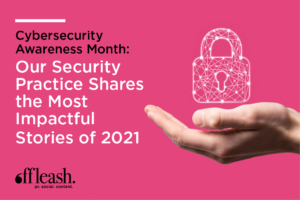Cybersecurity Awareness Month: Our Security Practice Shares the Most Impactful Stories of 2021

2021 has been a turbulent year for cybersecurity. As attackers capitalized on vulnerabilities exacerbated by the pandemic, the media had their hands full covering what President Joe Biden called “a constant and ever-increasing threat from malicious cyber actors.”
As we wrap up October and Cybersecurity Awareness Month, our security practice reflected on the most impactful stories from this year so far.
Tanaya Lukaszewski, Vice President
In May, we saw one of the most severe ransomware attacks ever—on the Colonial Pipeline, an American oil pipeline responsible for transporting gasoline and jet fuel primarily to the southeastern United States.
This incident dominated headlines for weeks and made “ransomware” a household term among consumers. The Wall Street Journal’s interview with Joseph Blount, CEO of Colonial Pipeline Co., was impactful for two reasons: First, because of the raw account given by Blount about the difficult position he was put in and the tough decisions he had to navigate. And second, because this article (along with others) continues to drive awareness around ransomware attacks and the importance of having a strong cybersecurity posture.
Read the Wall Street Journal article by Collin Eaton and Dustin Volz here.
Bianca Gorospe, Media Strategist
2021 has tested our cyber-resiliency more than ever before. Although data breaches and ransomware attacks dominated headlines, SC Magazine’s Bradley Barth wrote a piece on something entirely different earlier this year: how blind individuals are exploring various careers in the cybersecurity industry.
I thought this article was absolutely moving. The human side of cybersecurity has always been an area of personal interest, and I love seeing the heroes behind the scenes being highlighted.
Read the SC Magazine article by Bradley Barth here.
Shannon Campbell, Senior Account Manager
As fast-moving as the security space is—there are several security incidents that can be covered on any given day—I love reading longform pieces that dive deep into the backstory. Andy Greenberg is one of the best reporters out there today covering security through this lens.
One example that stands out is an article he wrote earlier this year about two people’s attempt to solve a very real problem—the inconsistency of McDonald’s ice cream machines—through a hacking device, and the subsequent legal fallout.
Read the WIRED article by Andy Greenberg here.
Erica Anderson, Account Manager
As someone who has worked in PR and marketing for years, I was intrigued by Becca Chambers’ article on why marketing can pose a threat to cybersecurity. It makes you realize that no industry is untouchable and that every company, every department, and every employee needs to open their eyes to cybersecurity threats.
The following quote serves as a great reminder: “Today, every department within an organization should be working in lockstep with the IT team…it’s time organizations of all sizes roll up their sleeves, coordinate with the IT team, and establish best practices for protecting data.” While advances in technology and data allow marketers to do their jobs more efficiently, that also comes with more responsibility and the need for greater vigilance.
Read the Forbes article by Becca Chambers here.
Eileen Drury, Senior Account Executive
This year felt like a never-ending cycle of ransomware attack news, and it was easy to forget that not all cybersecurity attacks are launched by groups seeking monetary gain.
Tim Starks’ story around a teenager who was able to rig votes to win a high school homecoming contest was a reminder that attacks come in all shapes and sizes, and that assets are never too small to protect. Aside from this story, CyberScoop has served as a beacon for reliable security reporting, diving deep into cybercrime, the attack groups behind it, and how the government is working with organizations to be better protected.
Read the CyberScoop article by Tim Starks here.
Alex Birmingham, Account Executive
When the average person (including myself) thinks of cyber attacks, usually what comes to mind is data breaches or stolen online accounts—not oil pipelines.
The attack on the Colonial Pipeline was the first time that a cyber attack affected a large portion of everyday citizens, including people in my life. Most of the time, these attacks are just things we hear about on the news. The Colonial Pipeline incident shed light on the underinvestment in our critical infrastructure and lack of preparedness for an attack at this scale.
David Jones wrote multiple articles that detailed the attack, as well as the flaws and warning signs that made the United States’ critical infrastructure vulnerable. Hopefully all the media attention this incident received will help to prevent similar attacks in the future.
Read the Cybersecurity Dive article by David Jones here.
Madison Gerchow, Assistant Account Executive
I always felt that worrying about cyber threats wasn’t necessary for the average, everyday person. I had only considered attacks to be threats to big tech companies, which were ultimately “safe” because they have the resources to handle them. This article from the Wall Street Journal shows us that these malicious onslaughts are sometimes right in our backyard, and the trickle-down effect can have serious consequences for all people.
Read the Wall Street Journal article by Kevin Poulsen, Robert McMillan, and Melanie Evans here.
As Cybersecurity Awareness Month draws to a close, the media deserves the nation’s gratitude for working so diligently to keep us informed. One can only hope they’re not so busy in 2022.
Eileen drives media relations and thought leadership for clients in a wide variety of spaces, including cybersecurity, enterprise software, mobile, customer experience, and content management. Contact Eileen here.